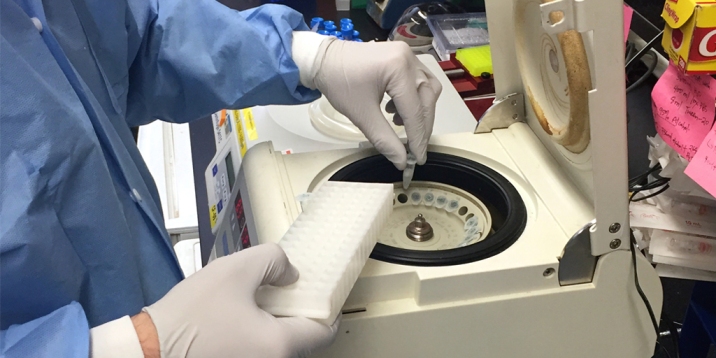
Basic Research: Building a Firm Foundation for Biomedicine

Credit: National Institute of Allergy and Infectious Diseases, NIH
A major part of NIH’s mission is to support basic research that generates fundamental knowledge about the nature and behavior of living systems. Such knowledge serves as the foundation for the biomedical advances needed to protect and improve our health—and the health of generations to come.
Of course, it’s often hard to predict how this kind of basic research might benefit human populations, and the lag time between discovery and medical application (if that happens at all) can be quite long. Some might argue, therefore, that basic research is not a good use of funds, and all of NIH’s support should go to specific disease targets.
To counter that perception, I’m pleased to share some new findings that underscore the importance of publicly supported basic research. In an analysis of more than 28 million papers in the PubMed.gov database, researchers found NIH contributed to published research that was associated with every single one of the 210 new drugs approved by the Food and Drug Administration from 2010 through 2016 [1]. More than 90 percent of that contributory research was basic—that is, related to the discovery of fundamental biological mechanisms, rather than actual development of the drugs themselves.
Previous attempts to quantify the contribution of federal funding to new drug development had looked primarily at patents. Most have focused on patents specifically licensed to pharmaceutical companies from academic institutions, where the vast majority of basic biological research takes place in America, most of it supported by NIH. Such studies suggested that 10 percent or less of newly approved drugs were based on academic patents. While interesting, those studies largely missed the broader influence of basic research results, which typically are published, not patented.
To take this broader view, researchers at Bentley University, Waltham, MA, led by Ekaterina Galkina Cleary, Jennifer Beierlein, and Fred Ledley, turned to the PubMed.gov database. The team set out to examine the full scope of NIH support associated with recent drug approvals.The researchers, who are not NIH grantees, recently published the results of their analysis in the Proceedings of the National Academy of Sciences.
As outlined in the paper, the researchers first identified all new molecular entities (NMEs) approved by the FDA from 2010 to 2016. The term NME refers to molecules that are unique among regulated or approved drug products in their mode of activity.
This first exercise resulted in a list of 210 new drugs. Of those, 197 were associated with 151 specific molecular targets. The remaining 13 NMEs had no known target. The FDA designated 84 of those 210 NMEs as “first in class,” meaning that they were designed to “hit” a completely novel biological target.
The next step was to compile an even longer list of related publications. Most prominently, they assembled a list of all journal articles in the PubMed.gov database featuring one of the 210 approved NMEs or one of their 151 molecular targets. Ultimately, that longer list uncovered about 130,000 publications featuring one of the NMEs, and nearly 2 million featuring their biological targets.
The final step was to cross-reference that long list of publications from PubMed.gov with publications found in the NIH RePORTER database, an electronic tool that allows users to search through all NIH-funded research projects from the past 25 years. The researchers found NIH-supported publications associated with 198 of the 210 new drugs and every one of their 151 molecular targets. In other words, NIH funding played a role, directly or indirectly, in every one of the new drugs approved over the selected time period.
About 30 percent of the 2 million publications that Ledley’s team uncovered were supported by NIH funds. That funding represented more than 200,000 fiscal years of project support (number of projects multiplied by their years funded) at a cost of more than $100 billion from 2000 to 2016. That comes to about 20 percent of the NIH budget. The 84 first-in-class NMEs approved over the same time period were associated with more than $64 billion of NIH funds.
Interestingly, the largest fraction—53 percent—of NIH grants leading to new drug approvals represented R01 research project grants. R01 grants are the oldest NIH funding mechanism, which often support investigator-initiated research.
All in all, the findings show that the contribution of publicly supported basic science to the development of the most promising recent new therapeutic advances has been even greater than had been appreciated. As we look ahead to the future, the biomedical advances needed to protect and improve our health—and the health of generations to come—will continue to depend on a firm foundation of knowledge built on basic research.
Reference:
[1] Contribution of NIH funding to new drug approvals 2010-2016. Galkina Cleary E, Beierlein JM, Khanuja NS, McNamee LM, Ledley FD. Proc Natl Acad Sci U S A. 2018 Feb 12. pii: 201715368.
Links:
PubMed.gov (National Library of Medicine/NIH)
NIH RePORTER (NIH)
Center for Integration of Science and Industry (Bentley University, Waltham, MA)






















.png)











No hay comentarios:
Publicar un comentario